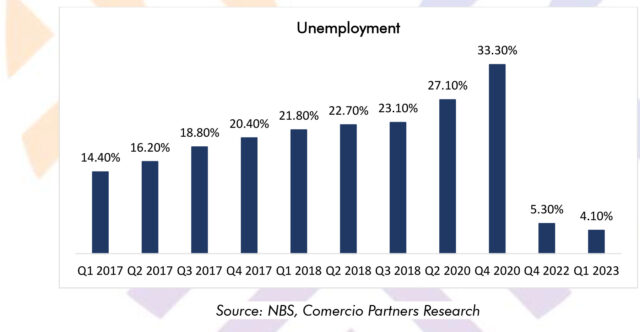TUE, AUGUST 29 2023-theGBJournal | Unemployment has been a longstanding challenge for Nigeria, with significant implications for its economy and society.
However, a recent change in methodology for measuring unemployment has revealed a remarkable transformation in the country’s unemployment landscape.
This change was driven by the need to align with international standards and provide a more comprehensive view of labour underutilization.
This report explores how Nigeria’s adoption of new International Labor Organization (ILO) guidelines has led to a substantial reduction in reported unemployment rates and discusses the implications of this change for the Nigerian economy.
The Methodology Shift and Its Rationale:
In response to the evolving labour market landscape and the need for cross-country comparability, Nigeria embraced new guidelines set forth by the ILO’s 19th International Conference of Labor Statisticians (ICLS) in 2014. These guidelines advocated for a broader measurement of labour underutilization, recognizing all forms of work, paid or unpaid. The new standards also aimed to integrate labour statistics with GDP, thereby providing a more holistic understanding of labour’s contribution to the economy.
The previous methodology, based on ILO’s 1983 guidelines, failed to capture the dynamics of the modern labour market, including the significant informal sector and the prevalence of unpaid work in Nigeria. By acknowledging and accounting for these aspects, the new methodology sheds light on a more accurate representation of the employment landscape.


Massive Reduction in Unemployment:
The most striking outcome of this methodology shift is the substantial decline in Nigeria’s reported unemployment rate. According to the National Bureau of Statistics (NBS) report, Nigeria’s unemployment rate plummeted from 33.3% in Q4 2020 to a mere 4.1% in Q1 2023.
This dramatic reduction underscores the importance of considering various forms of work, including informal and unpaid, in the measurement process.
In Q4 2022 and Q1 2023, 73.1% and 75.4% of employed Nigerians respectively, worked in their own business or farming activity for their primary job. On the other hand, 13.4% (in Q4 2022) and 11.8% (in Q1 2023) of employed Nigerians were engaged as employees (being wage-employed) in their primary jobs.
A further 10.7% (in Q4 2022) and 10.5% (in Q1 2023) of employed Nigerians were primarily engaged in helping in a household business, receiving pay or profit indirectly even if it was not their own business. A small proportion of employed Nigerians were primarily engaged as apprentices or interns (2.6% in Q4 2022 and 2.2% in Q1 2023). Those helping a household member who worked for someone else was about 0.2% in both Q4 2022 and Q1 2023.
The revised statistics present a transformative perspective on Nigeria’s labour market and hold significant implications for the economy:
-Informal Sector Recognition: The new methodology acknowledges the substantial contribution of the informal sector to the economy, revealing that a large proportion of working-age Nigerians are engaged in some form of economic activity. This recognition can lead to more targeted policies to support and regulate the informal sector, potentially boosting economic growth.
-Underemployment Insights: While the headline unemployment rate has decreased significantly, the underemployment rate remains a concern. Many employed individuals work fewer hours than desired and are willing to work more. Addressing this underemployment can lead to increased productivity and job satisfaction.
-Policy Precision: With a more nuanced understanding of the labour market, policymakers can craft interventions that align with the true challenges faced by the workforce. This might involve measures to improve job quality, skill development, and access to decent work opportunities.
-Reduction in Misery: Since the Unemployment rate is a significant factor in the Misery Index, a decrease in unemployment would result in a lower misery score for Nigerians. However, this reduction wouldn’t lead to significant changes in individuals’ lives, as there haven’t been any fundamental improvements in living standards.
While the adoption of the new International Labour Organization (ILO) guidelines for measuring unemployment in Nigeria has provided valuable insights and led to a significant reduction in reported unemployment rates, it’s important to acknowledge that no methodology is without limitations. Here are some limitations associated with the new methodology:
-Complexity of Informal Sector: While the new methodology aims to capture the informal sector’s contribution to the economy, measuring informal work can be inherently challenging.
Informal activities often lack formal records, making it difficult to accurately quantify their economic impact. Additionally, the boundaries between formal and informal work can be blurred, posing challenges in classification. The problem Is usually enhanced when the economic structure of the country has a large Informal sector.
-Subjective Nature of Underemployment: The underemployment rate, which considers individuals working fewer hours than desired, relies on self-reported willingness to work more hours. This introduces subjectivity and potential biases in reporting, as individuals’ perceptions of suitable working hours can vary widely.
-Unpaid Work: While the new methodology aims to capture unpaid work, accurately valuing such activities in economic terms can be difficult. Assigning a monetary value to unpaid work, such as household chores and caregiving, involves assumptions and approximations that may not fully reflect their true economic impact.
-Comparability Across Time: The shift to a new methodology makes direct comparisons of unemployment rates across different periods challenging. This is especially true when trying to compare rates before and after the methodology changes. Trend analysis might require careful adjustments to account for the methodological shift.
-Potential for Misinterpretation: The drastic reduction in reported unemployment rates could be misinterpreted as a sudden improvement in the labour market without considering broader economic and contextual factors. This could lead to misconceptions about the overall economic health of the country.
-Limited Scope: While the new methodology aims to capture various forms of work, there might still be aspects of labour underutilization that are not adequately addressed. For example, the methodology might not fully account for discouraged workers who have given up looking for employment altogether.
Bottomline
This recalibration of Nigeria’s labour market measurement not only challenges historical perspectives but also charts an altered trajectory for policy formulation and economic assessment. The transformed landscape bears far-reaching implications for diverse stakeholders.
However, it is imperative to acknowledge that while the adoption of the new International Labor Organization (ILO) guidelines offers invaluable insights, no methodology is devoid of limitations.
These limitations warrant careful consideration, ensuring that interpretations remain nuanced and grounded in the complex reality of the Nigerian labour market. This report is written by analysts at Comercio Partners Limited and made available to theGBJournal
Twitter-@theGBJournal|Facebook-the Government and Business Journal|email:gbj@govbusinessjournal.com| govandbusinessj@gmail.com










